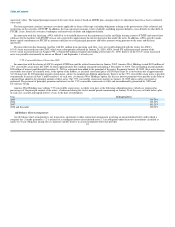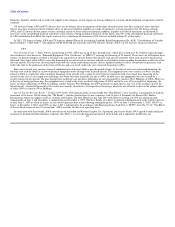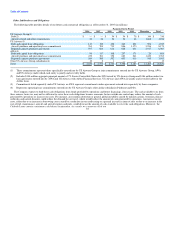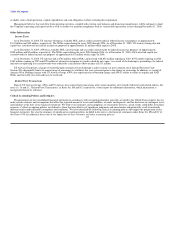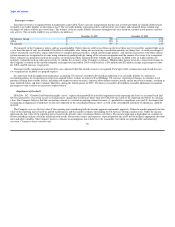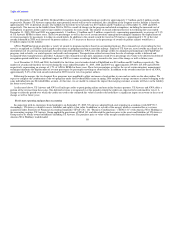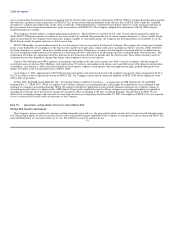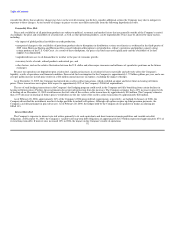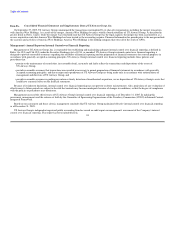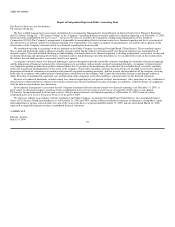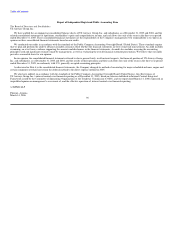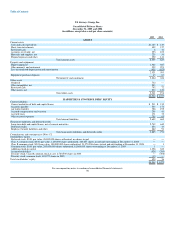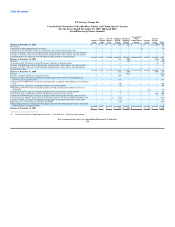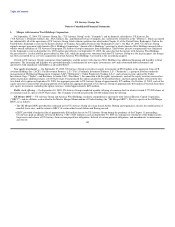US Airways 2005 Annual Report Download - page 97
Download and view the complete annual report
Please find page 97 of the 2005 US Airways annual report below. You can navigate through the pages in the report by either clicking on the pages listed below, or by using the keyword search tool below to find specific information within the annual report.
Table of Contents
cost is recognized in the financial statements beginning with the effective date, based on the requirements of SFAS 123R for all share-based payments granted
after that date, and based on the requirements of SFAS 123 for all unvested awards granted prior to the effective date of SFAS 123R. Under the "modified
retrospective" method, the requirements are the same as under the "modified prospective" method, but also permit entities to restate financial statements of
previous periods based on pro forma disclosures made in accordance with SFAS 123. The Company adopted the requirements of SFAS 123R using the
modified prospective method.
The Company currently utilizes a standard option pricing model (i.e., Black-Scholes) to measure the fair value of stock options granted to employees.
While SFAS 123R permits entities to continue to use such a model, the standard also permits the use of a more complex binomial, or "lattice" model. Based
upon research done by the Company on the alternative models available to value option grants, the Company has determined that it will continue to use the
Black-Scholes model for option valuation as of the current time.
SFAS 123R includes several modifications to the way that income taxes are recorded in the financial statements. The expense for certain types of option
grants is only deductible for tax purposes at the time that the taxable event takes place, which could cause variability in effective tax rates. SFAS 123R does
not allow companies to "predict" when these taxable events will take place. Furthermore, it requires that the benefits associated with the tax deductions in
excess of recognized compensation cost be reported as a financing cash flow, rather than as an operating cash flow as required under current literature. This
requirement will reduce net operating cash flows and increase net financing cash flows in periods after the effective date. These future amounts cannot be
estimated, because they depend on, among other things, when employees exercise stock options.
America West Holdings and AWA employee stock options outstanding at the time of the merger were fully vested in accordance with the change of
control provisions of America West Holdings' stock option plans. US Airways outstanding stock options were cancelled as part of the plan of reorganization.
Accordingly, as of January 1, 2006, only unvested director stock options, employee stock options, and stock appreciation rights granted subsequent to the
merger are subject to the transition provisions of SFAS 123R.
As of January 1, 2006, approximately 2,865,925 unvested stock options and stock-based awards with weighted average fair values ranging from $7.94 to
$11.34 are subject to the recognition provisions of SFAS 123R. The Company expects that the impact of adoption of SFAS 123R will be significant to the
2006 results of operations.
In May 2005, the FASB issued SFAS No 154, "Accounting Changes and Error Corrections — A replacement of APB Opinion No. 20 and FASB
Statement No. 3" ("SFAS 154"). SFAS 154 applies to all voluntary changes in accounting principle, and changes the requirements for accounting for and
reporting of a change in accounting principle. SFAS 154 requires retrospective application to prior periods' financial statements of a voluntary change in
accounting principle unless it is impracticable. APB Opinion 20 previously required that most voluntary changes in accounting principle be recognized by
including in net income of the period of the change the cumulative effect of changing to the new accounting principle. The provisions in SFAS 154 are
effective for accounting changes and correction of errors made in fiscal years beginning after December 15, 2005. The adoption of SFAS 154 is not expected
to have a material effect on the results of operations of the Company.
Item 7A. Quantitative and Qualitative Disclosures About Market Risk
Market Risk Sensitive Instruments
The Company's primary market risk exposures include commodity price risk (i.e., the price paid to obtain aviation fuel), interest rate risk and equity price
risk. The potential impact of adverse increases in these risks and general strategies employed by the Company to manage these risks are discussed below. The
risks identified below are consistent from year to year. The following sensitivity analyses do not
91


